Statistical analysis of the voting in Tula at SundayТs
elections to the city parliament demonstrates an obvious
correlation between the percentage of the votes obtained
by the parties and the voters turnover. The higher is the
turnout at an electoral district (a territory), the higher
is the average number of voters giving their votes for progovernmental
United Russia party, and, consequently, the lower is the
percentage for other parties. Also there is a clear correlation
between the percentage of the United Russia voters and those
who voted pre-term.
This abnormal correlation is observed both at breakdown
of the votes as of polling station and as of electoral district
(territory). Such a correlation is one more proof that United
Russia was bribing voters.
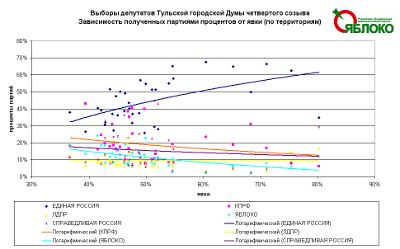
dark blue rhombus -United Russia
yellow triangle - Zhyrinovsky's LDPR
brown cross - Just Russia
pink square - CPRG
light blue rhombus Ц YABLOKO
Brown line Ц logarithmic (CPRF)
Light blue line Ц logarithmic (YABLOKO)
Dark blue line Ц logarithmic (United Russia)
Yellow line Ц logarithmic (LDPR)
Pink line Ц logarithmic (CPRF)
Vertical scale Ц percentage of votes cast
for different parties
Horizontal scale Ц voter turn out
Press
here to increase the graph.
At the Moscow City Duma election (October 11, 2009) statistical
analysis of the correlation of the votes obtained by a party
from the turnover showed the same picture: the higher was
the turnover, the more votes were cast for the United Russia
party and the lesser for other parties. Such a strange behaviour
of the voters is easy to explain through mass-scale fraud
in favour of United Russia: ballot stuffing and adding of
the votes of those who did not come vote.
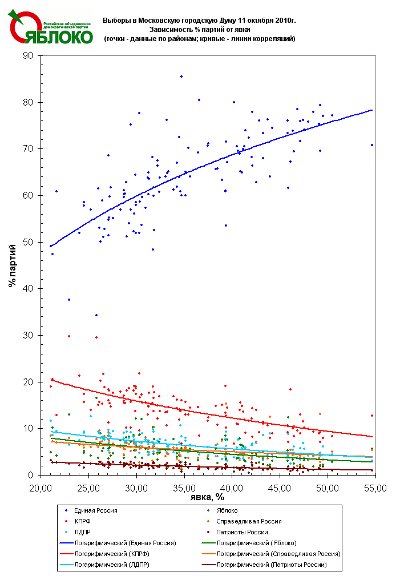
Compared to the Moscow election, when the "key"
technique of fraud was stuffing of ballots on the election
day, Tula demonstrated bribing of voters at pre-term voting.
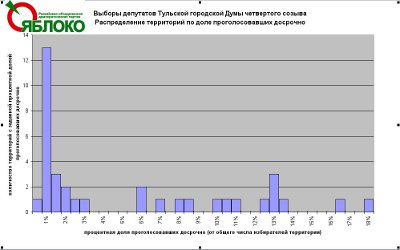
If there was no fraud, such a graph would like the part
of the graph up to 3% on the OX scale. This would mean that
voters behaved roughly in the same manner and that only
1% of the voters voted pre-term. However, our graph demonstrates
that such a pattern was observed only on half of the territories.
Voters of the other half suddenly demonstrated an unusual
activity and without any average behaviour pattern. The
graph shows splashes of activity (eg, around 8%, 11%, 13%
and 18%).
Also the share of those who voted pre-term as of the total
number of voters is very high Ц 10 (!) per cent on the average
in the city. Moreover, about one third of territories (whole
territories, not electoral districts) preterm voting amounted
to over 15 per cent of the total of the votes (for example,
the following territories: Sovetskaya (32) 23%, Centralnaya
(1) 26%, Privokzalnaya (1) 24%, Proletarskaya (16) 24%,
Centralnaya (27) 20%, Proletarskaya (19) 20%, Privokzalnaya
(5) 19%, Privokzalnaya (4) 18%, Proletarskaya (15) 17% and
Privokzalnaya (32) 17%).
Such a strange behaviour of voters proves that much work
had been done so that to make them come and vote pre-term.
Please see the video and a graph below to see how this was
achieved and in favour of what party.
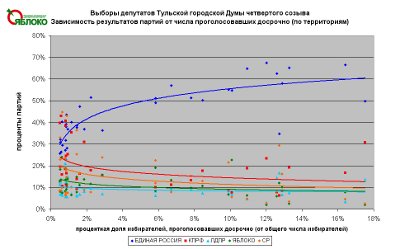
The graph shows that such pre-term voting was conducted
in favour of the United Russia. This party got the highest
percentage of votes at the territories with high pre-term
voting figures.
The dynamics of the УnightФ counting of the votes in the
City Electoral Commission is also as always interesting.
The table below demonstrates the official ballot for United
Russia grew together with the growth of voters turnover
against reduction of ballot for YABLOKO, the CPRF and Just
Russia.
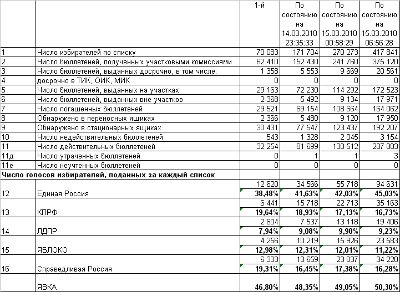
See also:
the
original in Russian
Regional
and Local Elections 2010
Tula region: violations
elections to the regional parliament. Press Release. March
14, 2010
Progovernmental
United Russia is buying off votes in Tula. Statement by
the party Chairman. March 12, 2010
Mass-scale buying of votes
in favour of the United Russia and the Just Russia party
observed at pre-term elections in Tula. Press Release, March
10, 2010